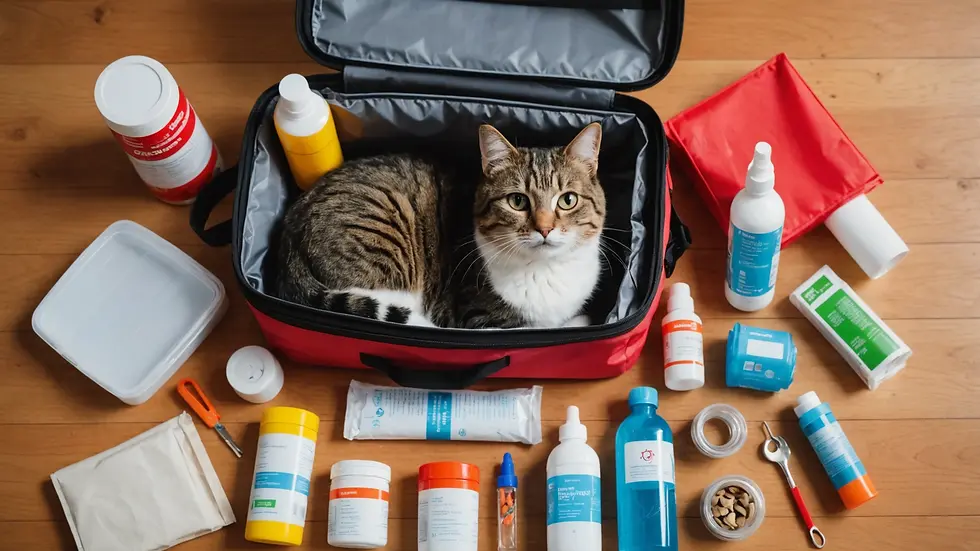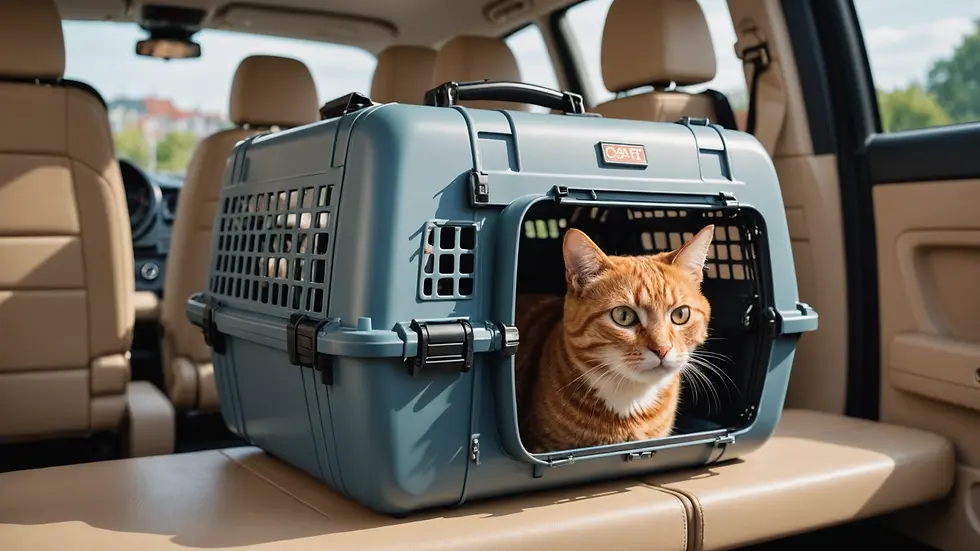Ensuring Feline Safety in Emergency Evacuations: Tips for Cat Owners
- Jyotiraj Borah
- Feb 11
- 6 min read
Emergencies can strike at any time, often with little or no warning. The thought of a hurried evacuation can leave cat owners feeling anxious. Cats are known for their independence and sometimes unpredictable behavior, which complicates their safety during such situations. This blog post provides cat owners with essential tips and strategies to ensure their feline companions stay safe, secure, and easily transported during an evacuation.
Understanding the Importance of Preparedness
Being prepared for an emergency is crucial. Natural disasters, fires, and other unforeseen events can require you to leave your home in minutes. Having a plan can make all the difference in keeping your cat safe.
Being prepared goes beyond just knowing how to exit your home. You also need the right supplies and resources at the ready. For instance, studies show that pets significantly improve their owners' emotional well-being, so having a solid plan is vital not only for their safety but also for your peace of mind. Cats thrive on routine, making it even more important to have a strategy for emergency situations.
Creating an Emergency Kit for Your Cat
The first step in preparing for emergencies is assembling a dedicated emergency kit for your cat. This kit should be easy to access and include essential items they might need. Important supplies to consider are:
Food and Water: Keep a minimum of three days’ worth of cat food and enough bottled water for both you and your cat. If your cat prefers a certain brand or flavor, stock up on that.
Litter and Litter Box: Pack a portable litter box, litter, and waste disposal bags to keep their area clean.
First-Aid Supplies: Gather any medications your cat might need, along with basic first-aid supplies like bandages and antiseptic wipes.
Comfort Items: Include your cat's favorite toys, bed, or blanket to help ease anxiety during stressful situations.
Identification: Ensure your cat wears a collar with an ID tag, and consider microchipping for added security. Studies indicate that microchipped pets are 20 times more likely to be reunited with their owners.
Having these items in an easily transportable container—like a sturdy backpack or dedicated crate—can save valuable time during an emergency. Regularly check your supplies to make sure everything is up to date, especially food and medications.

Choosing the Right Carrier
Selecting the right carrier is vital for your cat's comfort and safety during an evacuation. A good carrier should be sturdy, well-ventilated, and easy to carry. Here are some key considerations when choosing a carrier:
Size: Ensure the carrier allows your cat to stand, turn around, and lie down comfortably. For example, consider a carrier that measures at least 24 inches long for medium-sized cats.
Secure Closing Mechanism: Opt for a carrier with a secure latch to prevent your cat from escaping during transport.
Ventilation: Choose carriers with sufficient air vents to allow for easy breathing and to keep your cat calm.
Familiarization: Introduce your cat to the carrier before emergencies arise. Allowing them to explore and even nap inside can help reduce stress during evacuations.

Training Your Cat for Emergencies
Training your cat to respond to emergencies can be challenging but is greatly beneficial. Using positive reinforcement techniques can help your cat view their carrier and evacuation procedures positively. Here are steps you can take:
Link the Carrier with Positive Experiences: Encourage your cat to explore the carrier by placing treats and toys inside. This can help create a positive association.
Desensitization: Gradually expose your cat to evacuation-related sounds, like sirens. You can also practice basic commands like “come” or “go to your carrier.”
Mock Evacuations: Conduct practice drills by simulating evacuation scenarios. This can familiarize your cat with the routine and help reduce anxiety.
Keeping Calm During Evacuations
Cats are sensitive to their owners' emotions. Staying calm amid chaos is crucial. Here are some strategies to help maintain a peaceful atmosphere during an evacuation:
Practice Deep Breathing: Take deep breaths to ease anxiety. Staying calm helps reassure your cat.
Use Familiar Sounds: Bring a portable speaker to play calming music or your cat's favorite sounds during the evacuation.
Keep the Environment Familiar: If possible, bring along a blanket or item that smells like home to provide comfort during the chaos.
Additionally, try to adhere closely to your cat's routine during the evacuation process. Consistency can significantly decrease stress levels.
Finding Pet-Friendly Shelters
Finding temporary housing can become one of the most challenging aspects of an evacuation. Familiarize yourself with local regulations regarding pet-friendly shelters and hotels in advance:
Research Local Shelters: Identify nearby shelters that accommodate pets during emergencies and keep their contact information handy. For instance, FEMA has designated pet-friendly shelters in various regions.
List Pet-Friendly Hotels and Motels: Compile a list of pet-friendly accommodations along your evacuation route, ensuring you have multiple options available.
Government Resources: Check with state and local emergency services for information on programs or temporary housing options for pets during crises.
Being proactive about these arrangements can reduce worry during a real evacuation.
Communicating with Other Pet Owners
Connecting with fellow pet owners can be invaluable during emergencies. Here are a few strategies to enhance communication:
Join Local Pet Owner Groups: Engage in local cat clubs or community pet-owner groups for tips and support. These networks can be beneficial during emergencies.
Share Resources and Contacts: Keep a directory of local veterinarians, pet sitters, and shelters that can accept pets.
Use Social Media: Utilize community forums or social media networks to communicate evacuation plans or offer assistance.
Being part of a supportive community can lead to quicker, more effective solutions during emergencies, helping ensure you and your cat's safety.
Emergency Contact Information
Keeping crucial emergency contact information easily accessible is important for both you and your cat. Make sure to include:
Veterinarian Information: Have your veterinarian's contact details handy, especially if your cat needs medications or specific care.
Animal Poison Control: Store contact information for an animal poison control hotline in case your pet ingests something harmful.
Local Animal Shelters: Have the contact information for nearby animal shelters readily available for emergencies.
Organizing this information—in a digital format or as a physical printout—can save you valuable time when it matters most.
Understanding Your Cat’s Behavior in Crisis Situations
Cats often behave differently than humans during emergencies. Understanding your cat’s instincts can ensure their safety:
Hiding: Cats may try to find hiding spots when scared. Familiarize yourself with your cat's preferred places so you can locate them quickly.
Escaping: Make sure windows and doors are secure to prevent a frightened cat from escaping. A secure harness and leash can aid in containing them outdoors.
Vocalizations: Be attentive to the sounds your cat makes. Excessive vocalizations may signal distress and require immediate comfort.
Recognizing these behaviors enables you to meet your cat's needs more effectively during a crisis.
Establish a Post-Evacuation Routine
Once you've reached safety, establishing a routine will help your cat adjust to the new environment and alleviate stress. Consider these tips:
Set Up Their Space: Create a designated area with their bed, food, water, and litter box to help them feel at home in unfamiliar surroundings.
Maintain Structure: Keep feeding and playtimes as consistent as possible to provide familiarity.
Allow Time to Adjust: Give your cat space to acclimate while remaining close to reassure them.
Cats can adapt remarkably well, and your support will help them through transitions, even after a stressful evacuation.
Navigating Emergencies with Confidence
Emergency evacuations can be stressful, particularly for pet owners. By being proactive in planning and prioritizing your cat’s well-being, you can navigate these situations more effectively. From creating an emergency kit and training your cat to understanding their behavior during crises, every detail contributes to your feline companion's safety.
Take time to prepare, communicate effectively with fellow pet owners, and establish a comforting routine during emergencies. With a solid strategy in place, you can ensure that both you and your beloved cat remain safe and secure during any unforeseen event. Remember, preparation is essential, and your love for your feline friend will drive your commitment to protecting them when it matters most.




Comentarios